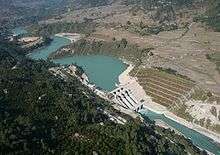Energy in Nepal

Nepal had a total primary energy supply (TPES) of 10.29 Mtoe in 2012.[1] Electricity consumption was 3.57 TWh. Most of this primary energy (about 80%) represents solid biofuels used in the residential sector (for heating, cooking etc.).[1] About 23% of the electricity is imported, with the rest almost completely supplied by hydroelectricity.
Nepal has no known major oil, gas, or coal reserves,[2] and its position in the Himalayas makes it hard to reach remote communities. Consequently, most Nepali citizens have historically met their energy needs with biomass, human labor, imported kerosene, and/or traditional vertical axis water mills. Energy consumption per capita is thus low, at one-third the average for Asia as a whole and less than one-fifth of the world average. The country has considerable hydroelectricity potential. The commercially viable potential is estimated at about 44 GW from 66 hydropower sites.[2] In 2010, the electrification rate was only 53% (leaving 12.5 million people without electricity) and 76% depended on wood for cooking.
With about 1 toe for every $1,000 of GDP, Nepal has the poorest energy intensity among all south Asian countries. The country has therefore very large energy efficiency potential.[1]
Oil products
Petroleum is the second largest energy fuel in Nepal after firewood and accounts for 11% of primary energy consumption in the country.[1] All petroleum products are imported from India. At the moment, the import of petroleum products is transacted exclusively between the Nepal Oil Corporation and the Indian Oil Corporation.[3] 75% of the imports are diesel, kerosene and gasoline. Due to the high energy demand in the country, the dependence on petroleum imports is increasing. More than 62% of the petroleum products are used in the transportation sector. Besides that, petroleum products constitute important energy sources for cooking purposes in households.
Biomass
Biomass is by far the most important primary energy source in Nepal. Biomass comprises wood, agricultural residues and dung. About 95% of the biomass is used for cooking and heating purposes in households.
Biogas
Farming system in Nepal is heavily dependent on livestock, with at least 1.2 million households owning cattle and buffalo. The technical biogas potential is therefore high and is estimated at at least one million household-size plants, 57 percent located in the Terai plains, 37 percent in the hills and 6 percent in remote hills.
According to Nepal's Alternative Energy Promotion Centre, as of July 2011, 241,920 biogas plants were installed in more than 2,800 Village Development Committees and in all 75 Districts under their Biogas Support Program.[4]
See also
References
- 1 2 3 4 "Nepal". www.iea.org. International Energy Agency (IEA). Retrieved 16 November 2015.
- 1 2 "Nepal". USAID South Asia Regional Initiative for Energy Integration (SARI/EI). Retrieved 16 November 2015.
- ↑ "About us". Nepal Oil Corporation. Retrieved 19 November 2015.
- ↑ "Installed biogas plants". Alternative Energy Promotion Centre (AEPC). Retrieved 19 November 2015.